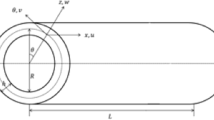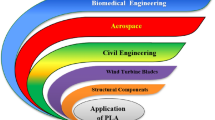Abstract
The materials industry is under increasing pressure to enhance performance while lowering costs and environmental impact. Three layers of functionally graded materials (FGMs) were proposed as a solution to this problem. The general goal of this research is to develop a semi-analytical method for solving the free vibration problem of FGMs in an infinite-length composite cylinder made of stainless steel (SS) and silicon nitride (SN). The formulation is based on Legendre polynomial approach and the use of specific rectangle window functions. This approach will result in an eigenvalue/eigenvector issue in the computation of normalized frequencies and displacement profiles. The effective material properties of FGM cylinders vary following the radial direction in conformity with the power-law distribution of the volume fractions. The numerical iteration approach was generated to create data utilizing MATLAB apps to investigate the free vibration analysis from specified boundary conditions. The results are obtained for longitudinal, torsional, and flexural modes. Then, the propagation of guided waves in three-layers (SN/SS/SN) of functionally graded cylinder with diverse gradient for each mode is studied. Accordingly, the results obtained demonstrate that the volumetric fraction of the FGM cylinder is significantly impacted by the graded-index. In addition, the graded-index has a major influence on the variation of the material’s properties in the radial direction. Furthermore, the dispersion curves of the normalized frequencies and phase velocities are significantly influenced by the graded-index. These results demonstrate that the phase velocities of the same mode increase as the exponents of the power-law increase. The displacement distributions are also explored to better understand the characteristics of the guiding waves inside the materials. Furthermore, the boundary conditions have a more significant influence on the normal stresses. High accuracy is found between our results and those published in the literature (error = 0.58%). This paper provides an important insight into the propagation of ultrasonic-guided waves in functionally graded multilayer cylindrical constructs for non-destructive testing.












Similar content being viewed by others
References
Liu, Z., Meyers, M.A., Zhang, Z., Ritchie, R.O.: Functional gradients and heterogeneities in biological materials: Design principles. functions, and bioinspired applications. Prog. Mater. Sci. 88, 467–498 (2017). https://doi.org/10.1016/j.pmatsci.2017.04.013
Kumar, S., Reddy, K.M., Kumar, A., Devi, G.R.: Development and characterization of polymer–ceramic continuous fiber reinforced functionally graded composites for aerospace application. Aerospace Sci. Technol. 26(1), 185–191 (2013). https://doi.org/10.1016/j.ast.2012.04.002
Yin, J., Lu, L., Cui, Y., Cao, Y., Zhang, P., Yan, Y., Du, Y.: Functional gradient films on aluminum alloy with high absorption efficiencies and damage thresholds for inertial confinement fusion applications. Ceram. Int. 48(13), 19180–19190 (2022). https://doi.org/10.1016/j.ceramint.2022.03.209
Pompe, W., Worch, H., Epple, M., Friess, W., Gelinsky, M., Greil, P., Schulte, K.J.M.S.: Functionally graded materials for biomedical applications. Mater. Sci. Eng. A 362(1–2), 40–60 (2003). https://doi.org/10.1016/S0921-5093(03)00580-X
Yang, Y., Liu, Y.: A new boundary element method for modeling wave propagation in functionally graded materials. Eur. J. Mech. A Solids. 80, 103897 (2020). https://doi.org/10.1016/j.euromechsol.2019.103897
Lefebvre, J.E., Zhang, V., Gazalet, J., Gryba, T., Sadaune, V.: Acoustic wave propagation in continuous functionally graded plates: an extension of the Legendre polynomial approach. IEEE Trans. Ultrason. Ferroelectr. Freq. Control 48(5), 1332–1340 (2001). https://doi.org/10.1109/58.949742
Yu, J.G., Ratolojanahary, F.E., Lefebvre, J.E.: Guided waves in functionally graded viscoelastic plates. Compos. Struct. 93(11), 2671–2677 (2011). https://doi.org/10.1016/j.compstruct.2011.06.009
Yu, J., Lefebvre, J.E., Elmaimouni, L.: Guided waves in multilayered plates: an improved orthogonal polynomial approach. Acta Mech. Solida Sin. 27(5), 542–550 (2014). https://doi.org/10.1016/S0894-9166(14)60062-8
Zhang, B., Yu, J.G., Zhang, X.M., Elmaimouni, L.: Guided wave propagating in a 1-D hexagonal piezoelectric quasi-crystal plate. Acta Mech. 232(1), 135–151 (2021). https://doi.org/10.1007/s00707-020-02811-7
Zhang, B., Yu, J., Zhang, X., &Elmaimouni, L.: Guided wave characteristics in the functionally graded two‐dimensional hexagonal quasi‐crystal plate. ZAMM J. App. Math. Mech./Zeitschrift für AngewandteMathematik und Mechanik, 100(11), e201900210 (2020). https://doi.org/10.1002/zamm.201900210
Zhang, B., Yu, J., Zhou, H., Zhang, X., Elmaimouni, L.: Guided waves in a functionally graded 1-D hexagonal quasi-crystal plate with piezoelectric effect. J. Intell. Mater. Syst. Struct. 33(13), 1678–1696 (2022). https://doi.org/10.1177/1045389X211063952
Liu, C., Yu, J., Xu, W., Zhang, X., Wang, X.: Dispersion characteristics of guided waves in functionally graded anisotropic micro/nano-plates based on the modified couple stress theory. Thin-Walled Struct 161, 107527 (2021). https://doi.org/10.1016/j.tws.2021.107527
Amor, M.B., Salah, I.B., Ghozlen, M.H.B.: Propagation behavior of lamb waves in functionally graded piezoelectric plates. Acta Acustica United Acustica 101(3), 435–442 (2015). https://doi.org/10.3813/AAA.918839
Kiełczyński, P., Szalewski, M., Balcerzak, A., Wieja, K.: Inverse method for determining profiles of elastic parameters in the functionally graded materials using love waves. Acta Acust. Acust. 102(3), 428–435 (2016). https://doi.org/10.3813/AAA.918961
Li, C.L., Han, Q., Liu, Y.J., Xiao, D.L.: Guided wave propagation in rotating functionally graded annular plates. Acta Mech. 228(3), 1083–1095 (2017). https://doi.org/10.1007/s00707-016-1752-9
Wang, X.X., Yu, J.G., Zhang, B., Elmaimouni, L., Zhang, X.M., Wang, X.H.: Lamb waves propagating in functionally graded 1-D quasi-crystal couple stress nanoplates. Acta Mech. 233(8), 3021–3033 (2022). https://doi.org/10.1007/s00707-022-03274-8
Daikh, A.A., Belarbi, M.O., Ahmed, D., et al.: Static analysis of functionally graded plate structures resting on variable elastic foundation under various boundary conditions. Acta Mech (2022). https://doi.org/10.1007/s00707-022-03405-1
Gong, S.W., Lam, K.Y., Reddy, J.N.: The elastic response of functionally graded cylindrical shells to low-velocity impact. Int. J. Impact Eng. 22(4), 397–417 (1999). https://doi.org/10.1016/S0734-743X(98)00058-X
Han, X., Liu, G.R., Xi, Z.C., Lam, K.Y.: Characteristics of waves in a functionally graded cylinder. Int. J. Numer. Meth. Eng. 53(3), 653–676 (2002). https://doi.org/10.1002/nme.305
Han, X., Liu, G.R.: Elastic waves in a functionally graded piezoelectric cylinder. Smart Mater. Struct. 12(6), 962–971 (2003). https://doi.org/10.1088/0964-1726/12/6/014
Wu, B., Su, Y., Liu, D., Chen, W., Zhang, C.: On propagation of axisymmetric waves in pressurized functionally graded elastomeric hollow cylinders. J. Sound Vib. 421, 17–47 (2018). https://doi.org/10.1016/j.jsv.2018.01.055
Bezzie, Y.M., Woldemichael, D.E.: Effects of graded-index and Poisson’s ratio on elastic-solutions of a pressurized functionally graded material thick-walled cylinder. Forces Mech. 4, 100032 (2021). https://doi.org/10.1016/j.finmec.2021.100032
Chan, D.Q., Quan, T.Q., Phi, B.G., et al.: Buckling analysis and dynamic response of FGM sandwich cylindrical panels in thermal environments using nonlocal strain gradient theory. Acta Mech. 233, 2213–2235 (2022). https://doi.org/10.1007/s00707-022-03212-8
Elmaimouni, L., Lefebvre, J.E., Zhang, V., Gryba, T.:Guided waves in radially graded cylinders: a polynomial approach. NDT&E International 38(3), 344–353 (2005). https://doi.org/10.1016/j.ndteint.2004.10.004.
Zhang, B., Yu, J.G., Zhang, X.M., Wang, X.H.: Waves in the multilayered one-dimensional hexagonal quasi-crystal plates. Acta Mech. Solida Sin. 34(1), 91–103 (2021)
Zhang, B., Wang, X.H., Elmaimouni, L., Yu, J.G., Zhang, X.M.: Axial guided wave characteristics in functionally graded one-dimensional hexagonal piezoelectric quasi-crystal cylinders. Math. Mech. Solids 27, 125–143 (2021). https://doi.org/10.1177/10812865211013458
Zhang, X., Li, Z., Yu, J., Zhang, B.: Properties of circumferential non-propagating waves in functionally graded piezoelectric cylindrical shells. Adv. Mech. Eng. 11(4), 168781401983687 (2019). https://doi.org/10.1177/1687814019836878
Yu, J.G., Zhang, B., Elmaimouni, L., Zhang, X.M.: Guided waves in layered cylindrical structures with sectorial cross-section under axial initial stress. Mech. Adv. Mater. Struct. 28(5), 457–466 (2021). https://doi.org/10.1080/15376494.2019.1572842
Auld, B.A.: Acoustic fields and waves in solids. Krieger, Malabar, FL (1990)
Author information
Authors and Affiliations
Corresponding author
Ethics declarations
Conflict of interest
The authors declare no competing of interest.
Additional information
Publisher's Note
Springer Nature remains neutral with regard to jurisdictional claims in published maps and institutional affiliations.
Appendix
Appendix
The elements needed to calculate the eigenvalues and eigenvectors:
Rights and permissions
Springer Nature or its licensor (e.g. a society or other partner) holds exclusive rights to this article under a publishing agreement with the author(s) or other rightsholder(s); author self-archiving of the accepted manuscript version of this article is solely governed by the terms of such publishing agreement and applicable law.
About this article
Cite this article
Raghib, R., Naciri, I., Khalfi, H. et al. Vibration analysis of a multilayer functionally graded cylinder with effects of graded-index and boundary conditions. Acta Mech 234, 3933–3953 (2023). https://doi.org/10.1007/s00707-023-03590-7
Received:
Revised:
Accepted:
Published:
Issue Date:
DOI: https://doi.org/10.1007/s00707-023-03590-7




